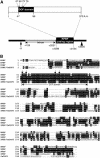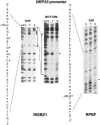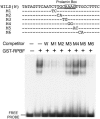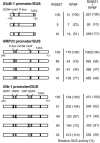Synergism between RPBF Dof and RISBZ1 bZIP activators in the regulation of rice seed expression genes
- PMID: 16798940
- PMCID: PMC1533958
- DOI: 10.1104/pp.106.082826
Synergism between RPBF Dof and RISBZ1 bZIP activators in the regulation of rice seed expression genes
Abstract
The Dof (DNA binding with one finger) transcriptional activator rice (Oryza sativa) prolamin box binding factor (RPBF), which is involved in gene regulation of rice seed storage proteins, has been isolated from rice cDNA expressed sequence tag clones containing the conserved Dof. RPBF is found as a single gene per haploid genome. Comparison of RPBF genomic and cDNA sequences revealed that the genomic copy is interrupted by one long intron of 1,892 bp in the 5' noncoding region. We demonstrated by transient expression in rice callus protoplasts that the isolated RPBF trans-activated several storage protein genes via an AAAG target sequence located within their promoters, and with methylation interference experiments the additional AAAG-like sequences in promoters of genes expressed in maturing seeds were recognized by the RPBF protein. Binding was sequence specific, since mutation of the AAAG motif or its derivatives decreased both binding and trans-activation by RPBF. Synergism between RPBF and RISBZ1 recognizing the GCN4 motif [TGA(G/C)TCA] was observed in the expression of many storage protein genes. Overexpression of both transcription factors gave rise to much higher levels of expression than the sum of individual activities elicited by either RPBF or RISBZ1 alone. Furthermore, mutation of recognition sites suppressed reciprocal trans-activation ability, indicating that there are mutual interactions between RISBZ1 and RPBF. The RPBF gene is predominantly expressed in maturing endosperm and coordinately expressed with seed storage protein genes, and is involved in the quantitative regulation of genes expressed in the endosperm in cooperation with RISBZ1.
Figures







Similar articles
-
Differences in transcriptional regulatory mechanisms functioning for free lysine content and seed storage protein accumulation in rice grain.Plant Cell Physiol. 2010 Dec;51(12):1964-74. doi: 10.1093/pcp/pcq164. Epub 2010 Oct 29. Plant Cell Physiol. 2010. PMID: 21037241
-
Compensation and interaction between RISBZ1 and RPBF during grain filling in rice.Plant J. 2009 Sep;59(6):908-20. doi: 10.1111/j.1365-313X.2009.03925.x. Epub 2009 May 18. Plant J. 2009. PMID: 19473328
-
A rice functional transcriptional activator, RISBZ1, responsible for endosperm-specific expression of storage protein genes through GCN4 motif.J Biol Chem. 2001 Apr 27;276(17):14139-52. doi: 10.1074/jbc.M007405200. Epub 2000 Dec 22. J Biol Chem. 2001. PMID: 11133985
-
The role of the DNA-binding One Zinc Finger (DOF) transcription factor family in plants.Plant Sci. 2013 Aug;209:32-45. doi: 10.1016/j.plantsci.2013.03.016. Epub 2013 Apr 15. Plant Sci. 2013. PMID: 23759101 Review.
-
The importance of being flexible: the case of basic region leucine zipper transcriptional regulators.Curr Protein Pept Sci. 2009 Jun;10(3):244-69. doi: 10.2174/138920309788452164. Curr Protein Pept Sci. 2009. PMID: 19519454 Free PMC article. Review.
Cited by
-
The NAC Transcription Factors OsNAC20 and OsNAC26 Regulate Starch and Storage Protein Synthesis.Plant Physiol. 2020 Dec;184(4):1775-1791. doi: 10.1104/pp.20.00984. Epub 2020 Sep 28. Plant Physiol. 2020. PMID: 32989010 Free PMC article.
-
Effect of Panicle Morphology on Grain Filling and Rice Yield: Genetic Control and Molecular Regulation.Front Genet. 2022 May 10;13:876198. doi: 10.3389/fgene.2022.876198. eCollection 2022. Front Genet. 2022. PMID: 35620460 Free PMC article. Review.
-
Over-Expressing TaSPA-B Reduces Prolamin and Starch Accumulation in Wheat (Triticum aestivum L.) Grains.Int J Mol Sci. 2020 May 5;21(9):3257. doi: 10.3390/ijms21093257. Int J Mol Sci. 2020. PMID: 32380646 Free PMC article.
-
Differentiation mechanism and function of the cereal aleurone cells and hormone effects on them.Plant Cell Rep. 2014 Nov;33(11):1779-87. doi: 10.1007/s00299-014-1654-z. Epub 2014 Jul 10. Plant Cell Rep. 2014. PMID: 25007781 Review.
-
Involvement of PpDof1 transcriptional repressor in the nutrient condition-dependent growth control of protonemal filaments in Physcomitrella patens.J Exp Bot. 2012 May;63(8):3185-97. doi: 10.1093/jxb/ers042. Epub 2012 Feb 15. J Exp Bot. 2012. PMID: 22345635 Free PMC article.
References
-
- Adachi T, Izumi H, Yamada T, Tanaka K, Takeuchi S, Nakamura R, Matsuda T (1993) Gene structure and expression of rice seed allergenic proteins belonging to the alpha-amylase/trypsin inhibitor family. Plant Mol Biol 21: 239–248 - PubMed
-
- Conlan RS, Hammond-Kosack M, Bevan M (1999) Transcription activation mediated by the bZIP factor SPA on the endosperm box is modulated by ESBF-1 in vitro. Plant J 19: 173–181 - PubMed
-
- Diaz I, Vicente-Carbajosa J, Abraham Z, Martinez M, Isabel-LaMoneda I, Carbonero P (2002) The GAMYB protein from barley interacts with the DOF transcription factor BPBF and activates endosperm-specific genes during seed development. Plant J 29: 453–464 - PubMed
Publication types
MeSH terms
Substances
Associated data
- Actions
- Actions
- Actions
LinkOut - more resources
Full Text Sources
Other Literature Sources
Molecular Biology Databases

